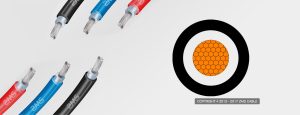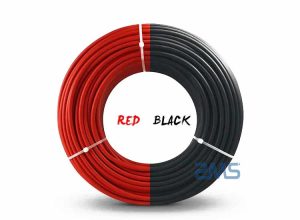Building cost-effective and profitable photovoltaic power plants represents the most important goal and core competence of all solar cable manufacturers.
Profitability depends not only on the efficiency or high performance of the solar modules themselves, but also on a series of components that on the surface do not appear to be directly related to the modules.
For example, if a PV plant fails to use the right cables, the lifetime of the entire system will be affected.
So, what is a PV cable?
PV cable is an electron beam cross-link cable rated at 120 °C. This rating corresponds to 18 years of service at a continuous temperature of 90 °C. And it lasts longer when the temperature is below 90 °C.

The characteristics of solar cables are determined by their special cable insulation and sheathing material, called cross-linked PE. Which is irradiated by an irradiation gas pedal to change the molecular structure of the cable material and thus provide its individual properties. During installation and maintenance, the cable can be routed on the sharp edges of the roof structure. While the cable is subjected to pressure, bending, tension, cross-tension loads, and strong impacts.
If the cable sheath is not strong enough, the cable insulation will be severely damaged. Thus affecting the life of the entire cable, or leading to short circuits, fires and injuries, and other dangerous problems.
In addition to the main equipment in the construction process of solar photovoltaic power plants. Such as photovoltaic modules, inverters, and step-up transformers. In addition to supporting the connection of solar cable materials to the overall profitability of photovoltaic power plants. The safety of operation, whether efficient, also plays a vital role.
The following is a detailed introduction to the common cables and materials used in photovoltaic power plants and their use of the environment.
Cables according to the photovoltaic power plant system can be divided into DC cables and AC cables, according to the use and use of different environments are classified as follows:
DC Cables
1 Series cables between components and modules.
2 Parallel cables between strings and between strings and the DC distribution box.
3 Cable between DC distribution box and inverter.
The above cables are DC cables, which are more often laid outdoors and need to be moisture-proof, sunproof, cold-proof, heat-proof, and UV-proof. And in some special environments, they also need to be protected from chemicals such as acids and alkalis.
AC Cable
1 Inverter to step-up transformer connection cable.
2 The connection cable from the step-up transformer to the distribution unit.
3 The connection cable from the distribution unit to the grid or the customer.
This part of the cable is an AC load cable, the indoor environment laying more, can be selected following the general power cable selection requirements.
Photovoltaic Special Cable
Solar power photovoltaic power stations in numerous DC cables to be laid outdoors, in harsh environmental conditions. The cable material should be based on resistance to ultraviolet light, ozone, severe temperature changes, and chemical erosion.
Common material cable in this environment for a long time will lead to the cable sheath being fragile, and even decomposing the cable insulation layer.
These conditions can directly damage the cable system and also increase the risk of short-circuiting the cable.
In the medium to long term, the possibility of fire or injury to personnel is also higher, greatly affecting the service life of the system. Therefore, it is essential to use PV-specific cables and components in PV power plants.
PV-specific cables and components are not only optimally resistant to weathering, UV, and ozone attack, but can also withstand a greater range of temperature variations.

Solar Cable Selection
The cables used in the low-voltage DC transmission part of a solar PV power system have different requirements for the connection of different components. Because of the use environment and technical requirements.
The overall factors to be considered are cable insulation performance, heat and flame resistance, aging performance, and wire diameter specifications.
Specific requirements are as follows:
1 Connecting Cable between Photovoltaic Cell Components
Generally use the connection cable attached to the module junction box to connect directly, the length is not enough to use a special extension cable.
Depending on the size of the component power, this type of connection cable has a cross-sectional area of 2.5 m㎡, 4.0 m㎡, 6.0 m㎡, and other three specifications.
This type of connection cable uses a double layer of insulation sheath. Which has superior resistance to ultraviolet light, water, ozone, acid, and salt erosion, superior all-weather capability, and wear resistance.
2 Connection Cable between Battery and Inverter
It is required to use UL-tested multi-strand flexible cable and connect as close as possible.
Choosing short and thick cables can reduce the loss of the system, improve efficiency and enhance reliability.
3 Connecting Cables between Battery Array and Controller, etc.
It is also required to use UL-tested multi-stranded flexible cable, and the cross-sectional area is based on the maximum output current of the array.
The DC cable cross-sectional area of each part is determined according to the following principles:
For the connection cable between solar modules and components, the connection cable between battery and battery. And the connection cable for AC load, the cable current rating is generally selected as 1.25 times the maximum continuous operating current in each cable.
The connection cables between solar cell arrays and arrays, the connection cables between battery banks and inverters. Generally, the selected cable-rated current is 1.5 times the maximum continuous operating current in each cable.
The above is a general introduction to solar cables, as well as some considerations when shopping for cables. ZMS cable manufacturer promises to have solar cables manufactured to international standards, as well as a variety of components and complete services. If you have any questions about the purchase of solar cables, please feel free to consult us. And we will have a professional cable sales representative to help you.